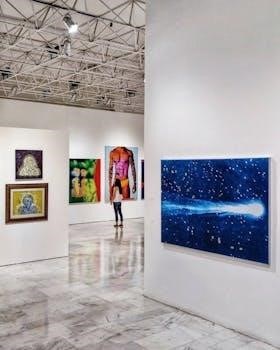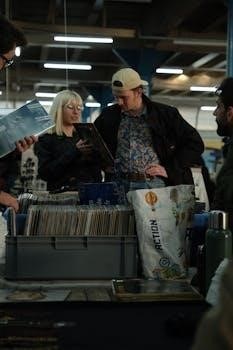Contemporary Collecting⁚ An Overview
This section explores the multifaceted world of modern collecting, particularly through the lens of academic research․ It delves into the motivations behind collecting practices and the social impact of these activities․ This overview sets the stage for understanding the complex dynamics involved․
Contemporary collecting, a dynamic field of study, examines the act of acquiring and organizing objects in the modern era․ It moves beyond simple accumulation, exploring the social, cultural, and psychological dimensions that drive these practices․ This area of research investigates what people choose to collect, why they collect, and the meanings they ascribe to their collections․ The study of contemporary collecting incorporates a variety of disciplines, including sociology, anthropology, and art history, providing a rich understanding of the phenomenon․ It considers collections not just as assemblages of things, but as reflections of personal identity, cultural values, and social trends․ This introduction sets the foundation for a deeper exploration of the subject matter․ Kevin Moist’s work will be a key focal point, offering valuable insights into these complex practices, including the fate of objects and their significance in the contemporary world․ The exploration of contemporary collecting also includes the analysis of virtual items as well as physical objects․
Kevin Moist’s Role in Collecting Studies
Kevin Moist is a significant figure in the field of collecting studies, contributing substantial research and analysis to our understanding of contemporary collecting․ His work, often in collaboration with others, explores the intricate relationships between objects, practices, and their cultural significance․ Moist’s perspectives are rooted in sociological and anthropological frameworks, allowing for a comprehensive examination of collecting as a cultural phenomenon․ His publications delve into the motivations behind collecting, focusing on how individuals imbue objects with personal and social meaning․ Moist’s approach emphasizes the dynamic nature of collections, showing how they are not static entities but rather are constantly evolving reflections of their owners and their contexts․ Furthermore, his writings address the “fate of things,” investigating how objects transition through different stages of their life cycle, from acquisition to eventual disposal or transformation․ Moist’s scholarly contributions significantly enhance the academic discourse on contemporary collecting, providing valuable insights into its complexities and its role in modern society, as well as virtual collecting․ His work is central to understanding the evolving nature of the field․

Key Themes in Moist’s Work
Moist’s research emphasizes the interplay between objects, practices, and their ultimate fate, examining collecting through sociological and anthropological lenses․ He also views collecting as a vital cultural practice․
Objects, Practices, and the Fate of Things
Kevin Moist’s work delves deeply into the relationship between collected items, the acts of collecting, and the eventual destiny of these objects․ He explores how the value and meaning of items are transformed through the collecting process․ This involves investigating not only the tangible aspects of possessions but also the emotional and cultural significance they acquire within a collection․ Moist analyzes how collecting practices shape the narrative and identity of the collector․ His research examines the lifecycle of collected items, from their acquisition to their potential dispersal or preservation, highlighting the dynamic and evolving nature of collecting․ He also considers the impact of cultural context and personal experiences in shaping these processes․ By considering these aspects, Moist provides a comprehensive perspective on collecting, linking the objects themselves with the behaviors and ultimate outcomes they encounter․
Sociological and Anthropological Perspectives on Collecting
Moist’s approach to studying collecting is heavily influenced by sociological and anthropological frameworks, offering a deeper understanding of why people collect․ He explores collecting not just as an individual pursuit but as a social practice embedded within cultural norms and values․ Moist examines how collecting activities reflect social relationships, identity construction, and group dynamics․ His work investigates the symbolic meanings of collected objects and how these meanings are negotiated within different social contexts․ By applying anthropological methods, he studies the rituals and behaviors associated with collecting, shedding light on the cultural significance of these practices across various communities․ His analysis also considers how collecting can be viewed as a form of communication and a way to create and maintain social identities; This interdisciplinary perspective provides a rich context for understanding the complex motivations and social functions of collecting․
Collecting as a Cultural Practice
Collecting, according to Moist, is not merely an accumulation of objects but a deeply ingrained cultural practice․ His work emphasizes that collecting is shaped by cultural norms, values, and shared meanings within specific communities․ He illustrates how different cultures have distinct traditions of collecting, each with its own set of rules, rituals, and social functions․ Moist examines how collecting serves as a mechanism for creating and reinforcing social identities, reflecting cultural preferences and historical contexts․ Furthermore, he explores the ways in which collecting influences the preservation and transmission of cultural heritage․ His research highlights the role of collecting in defining community boundaries and social status․ By viewing collecting as a cultural practice, Moist’s analysis provides a nuanced understanding of the complex interplay between objects, individuals, and social structures․ This perspective underscores that collecting practices are not universal but vary significantly across different cultural landscapes․

Related Research and Publications
This section examines key publications and research connected to Kevin Moist’s work․ It delves into the analysis of specific articles and their relation to broader collecting studies․ The section also highlights relevant connections with other scholars in the field․
“Collecting, Collage, and Alchemy” Article Analysis
This section provides an in-depth analysis of Kevin Moist’s article, “Collecting, Collage, and Alchemy⁚ The Harry Smith Anthology of American Folk Music as Art and Cultural Intervention․” The analysis examines how Moist explores the themes of collecting as a creative act, drawing parallels to collage and alchemical processes․ It investigates how the Harry Smith Anthology serves as a case study, revealing the cultural significance of compiled collections․ The discussion further highlights how Moist examines the transformative power of collections and their ability to recontextualize objects․ The article’s perspective on collections as a form of cultural intervention will be closely considered․ This analysis will explore the methodological approach used by Moist and evaluate its impact on the understanding of collecting․ We will delve into how Moist interprets the meaning behind the assembly of diverse elements into a cohesive collection․ The analysis will also look at how the article contributes to broader discussions about the nature of collecting and cultural value․
Connections to Belk’s Work on Collecting
This section explores the significant connections between Kevin Moist’s research on collecting and the foundational work of Russell Belk in the field․ Belk’s influential perspectives on collecting as a form of self-extension and identity construction provide a vital framework for understanding Moist’s contributions․ This discussion will highlight how Moist’s research builds upon Belk’s ideas, potentially expanding or challenging them through his focus on specific collecting practices and cultural contexts․ The analysis examines how Belk’s concepts of object attachment and the extended self resonate within Moist’s exploration of contemporary collecting․ It will also consider how Moist’s work may offer new insights into the sociological and anthropological aspects of collecting that Belk’s earlier research has laid the groundwork for․ We will examine if Moist’s research validates Belk’s theories or proposes a novel understanding of collecting behavior․ The section will clarify the intellectual lineage between these scholars and how their work, together, deepens the understanding of collecting as a social and cultural phenomenon․

Practical Applications
This section explores the real-world uses of collecting research․ From virtual tours for real estate to understanding consumer behavior in cosmetics, we see the impact of these studies․ These examples illustrate the practical relevance of collecting theories․
Real Estate and Virtual Tours
The application of collecting insights extends into the realm of real estate, particularly with the rise of virtual tours․ The data gathered from digital platforms allows for the creation of immersive experiences, enabling potential buyers to explore properties remotely․ This technological advancement transforms how real estate is viewed, marketed, and ultimately purchased․ These virtual tours, based on collected data, offer a convenient and engaging way for buyers to experience a space, leading to more informed decisions․ This integration of technology with a deeper understanding of buyer behavior, derived from collecting studies, proves to be a valuable tool in the modern real estate market․ The ability to collect and analyze data from virtual interactions enhances the customer experience and streamlines the purchasing process, demonstrating the practical implications of collecting research․ The use of these technologies has become essential for modern real estate agents and firms․
Cosmetics and Hair Care Products

The principles of collecting, focusing on objects and their significance, can also be seen in the consumption of cosmetics and hair care products․ These items, often collected and curated by individuals, are not merely functional but also carry symbolic meanings and personal narratives․ Brands like Kevin Murphy, known for their specialized hair care lines, demonstrate how products can become objects of collection․ The selection and acquisition of these products become a part of self-expression and personal identity construction․ The variety of formulations, such as those designed for moisture control or curl definition, highlights the diverse preferences and needs of consumers․ This focus on individual choice and the act of selecting specific items parallels the broader dynamics of collecting, emphasizing the cultural and social aspects of personal care․ The act of choosing specific brands and products can be seen as a form of self-curation․


